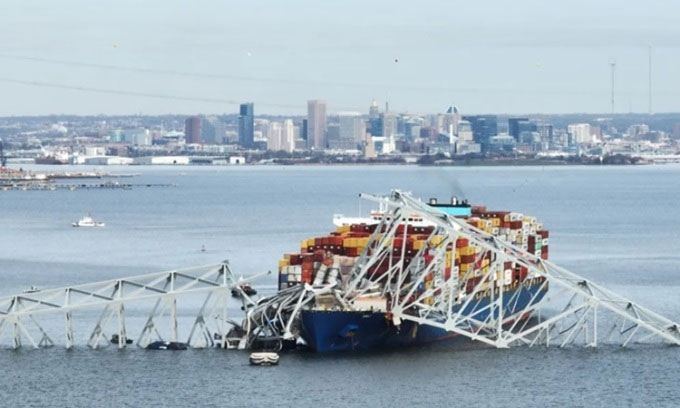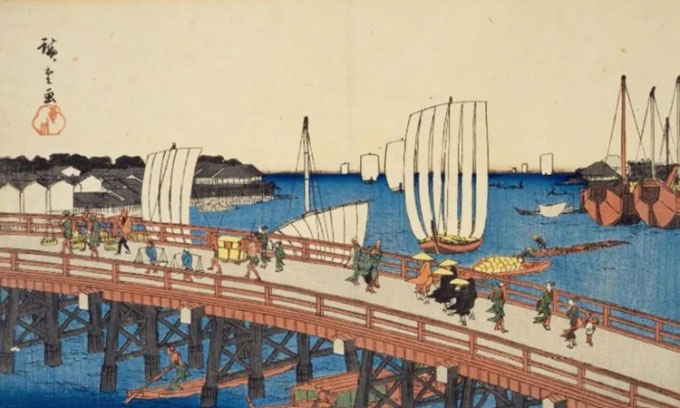Top 7 worst bridge collapse disasters in history
Many bridge collapse disasters around the world are the result of diverse causes, from design mistakes to extreme weather and human error.
Not long after 1:00 p.m. on March 26, the crew of the Dali, a cargo ship en route to Sri Lanka, sent an emergency signal, warning authorities that the ship had lost power. A few minutes later, the Dali crashed into the Francis Scott Key Bridge in Baltimore, causing the 47-year-old structure to collapse into the Patapsco River, killing six people after falling from the bridge into the river.
The ship crashed into support pillars before bursting into flames with bridges collapsing around it. The incident happened in a split second, the accident triggered a chain collapse, in which "damage in one structural member leads to damage in neighboring parts, which cannot support the new load placed above". , according to Andrew Barr, an engineer at the University of Sheffield in the UK.

The steel frame of the Francis Scott Key Bridge crushed the container ship during the bridge collapse on March 26. (Photo: AFP).
This structure is a continuous truss bridge, meaning it consists of a steel truss spanning three main spans. Although the bridge contractor had put in place protective measures to prevent structural damage, the size and force of the Dali's collision quickly overwhelmed these safety measures. The 1977 bridge may not have been equipped to handle the scale of ship movements today, according to Toby Mottram, emeritus engineer at the University of Warwick, UK.
Although authorities began investigating the cause of the accident and assessing economic damage, many things are still unclear. Although the accident caused great damage, this is not the first time such an incident has occurred. From 1960 to 2015, 35 major bridges around the world collapsed due to being hit by ships or barges, killing 342 people, according to a 2018 study. Historically, there are many examples of Bridge collapses, with different causes.
1. Eitaibashi Bridge in Japan in 1807

Eitaibashi wooden bridge in print photo. (Photo: British Museum).
Built in the late 17th century, the Eitaibashi wooden bridge spans the Sumidagawa River in Edo (present-day Tokyo). In 1807, crowds flocked to a local festival held on the bridge, causing the bridge to collapse under the weight of the crowd. A total of 1,400 people died in the disaster.
Eventually, the bridge was rebuilt, but the new construction was not much better than the previous version. In 1923, the Great Kanta Earthquake swept through Tokyo, killing more than 140,000 people and causing fires that destroyed much of the city. Eitaibashi Bridge is also among the structures destroyed by natural disasters.
2. Ponte das Barcas Bridge in Portugal in 1809
On March 29, 1809, under the command of Napoleon Bonaparte, the French army invaded the Portuguese city of Porto. Panic-stricken locals tried to flee across Ponte das Barcas, a pontoon bridge built in 1806 from 20 boats connected by steel ropes.
"People, young and old, both men and women, rushed forward in complete chaos, some already on the bridge, others trying to climb up in a frantic state," WFP historian Napier described the year. 1838. Overwhelmed by Portuguese residents and troops, the bridge collapsed, sending thousands of people falling into the Douro River. The exact number of casualties is unknown, but some contemporary scholars believe that the figure of 4,000 is somewhat exaggerated.
3. Dixon Bridge disaster in Illinois, USA, 1873

Dixon Bridge after the collapse. (Photo: Wikimedia).
After a series of wooden bridges across the Rock River in Illinois deteriorated, locals eagerly prepared plans for an iron bridge. In 1868, the Dixon City Council decided to move forward with Lucius E. Truesdell's design, ignoring engineers' warnings that the drawings contained serious errors. The bridge opened the following January, just a few weeks after another bridge also designed by Truesdell collapsed in the city of Elgin, although not causing deaths.
Four years later, on May 4, 1873, tragedy occurred during a riverside baptism organized by Reverend JH Pratt. According to the Chicago Tribune, the third person of the day had just stepped up to receive the ceremony when the bridge suddenly collapsed, causing nearly 200 people and 6 horses above to fall into the Rock River from a height of about 5.5 m. Some people sank into the water, others died before even touching the water. There were people caught in debris, some jumped from the bridge into the river and swam to shore. In total, the bridge collapse killed 46 people and injured 56. Scientific American concluded that the Truesdell Bridge accident was the result of faulty construction theory, poor and inadequate materials.
4. Quebec Bridge in Canada in 1907 and 1916
The Quebec Bridge in Canada collapsed not once but twice before it even opened. Construction of the world's longest cantilever bridge began in 1900. Before the first accident, workers noticed that major parts of the bridge structure were deformed, but authorities said this problem was not serious. serious enough to stop construction. Then, on the afternoon of August 30, 1907, a section of the bridge collapsed, nearly hitting a steamship passing below. Of the 86 workers on the bridge at that time, only 11 survived. An investigation blamed the engineers who built the bridge.
After the disaster, the government took charge of the project and assigned it to redesign the entire bridge. This time, the accident occurred at the end of the construction process, when workers lifted the central span into position in front of a crowd of tens of thousands of people on September 11, 1916. The lifting operation failed, causing 13 deaths. The bridge finally opened in 1917 and is still in use today.
5. Tacoma Bridge in Washington, USA, 1940
Nicknamed "Galloping Gertie" because it often bounces vertically on windy days, the Tacoma Narrows Bridge collapsed on November 7, 1940, just four months after its operation. That morning, when the wind reached 64 km/h, the suspension bridge began to twist sideways, tilting up to 8.5 m at a 45-degree angle, according to the Washington State Transportation Authority.
After noon, the 305 m long entrance at both ends of the giant structure began to break into many small pieces and fall. Local reporter Leonard Coatsworth was the last person on the bridge. He escaped by getting out of the car window and crawling 457 meters on both hands and feet. The bridge collapsed not long after.
6. Silver Bridge in West Virginia and Ohio, USA, 1967
The deadliest bridge collapse in modern history forced the United States to apply new safety measures. The suspension bridge that led to this change opened on the Ohio River in 1928, connecting the states of West Virginia and Ohio. The structure is officially called the Point Pleasant Bridge, but is widely known as the Silver Bridge due to its aluminum color.
At about 5 p.m. on December 15, 1967, the bridge overturned, starting slowly from the Ohio side, then gradually folding toward West Virginia, according to witnesses. 32 vehicles fell into the water and 46 people died. Investigators later determined that a small crack in one of the bridge's suspension beams (straight metal bars with holes or "eyes" at either end) caused the collapse. Undetectable to the naked eye, the crack can only be resolved by disassembling the suspension rod joint, which is impossible, according to the West Virginia Transportation Authority.
7. Sunshine Skyway Bridge in Florida, USA, 1980

Sunshine Skyway bridge collapse seen from above. (Photo: Tampa Bay Times).
The Sunshine Skyway Bridge in Florida is perhaps the closest example to the Francis Scott Key Bridge on the list. On May 9, 1980, the cargo ship MV Summit Venture crashed into a bridge support beam during a strong thunderstorm, causing a 366-meter section to fall into Tampa Bay. 6 cars, a truck and a bus crashed into the water, killing 35 people.
Bruce Atkins, a sailor on the cargo ship, said the storm arose suddenly with winds that obscured visibility. At that time, they were not aware of the wind causing the ship to change direction. Investigators later exonerated freight train operator John Lerro.
A replacement bridge opened over Tampa Bay in 1987. To prevent a similar tragedy in the future, engineers increased the height of the structure, while widening the canal below. Authorities also placed cement islands as underwater barriers around the bridge. Designed to withstand 13.6 million kg of force, the berm helps protect the bridge by redirecting incoming ships.
- The crowd walking could all collapse the bridge
- 10 worst disasters in US history
- Looking back at the 10 worst natural disasters in American history
- The newly released video of the bridge collapse moment in Italy left 43 people dead
- Anti-collapse technology
- Find out the darkest period in history, all kinds of disasters pouring down on humanity
- Why did the bridge in the US collapse so quickly when a freight train hit it?
- Impressive bridges in the world
- Large ice bridge collapses on the river in Argentina
- 13 beautiful fairy-like bridges worth admiring around the world
- The bridge of architectural masterpieces of the world
- The bridge 'engraved, carved out' is like magic
 'Fine laughs' - Scary and painful torture in ancient times
'Fine laughs' - Scary and painful torture in ancient times The sequence of numbers 142857 of the Egyptian pyramids is known as the strangest number in the world - Why?
The sequence of numbers 142857 of the Egyptian pyramids is known as the strangest number in the world - Why? History of the iron
History of the iron What is alum?
What is alum?